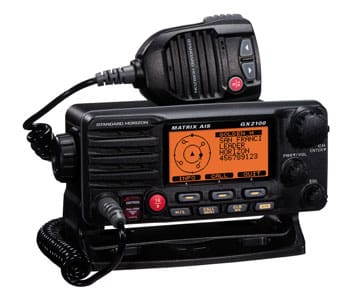Marine electronics functions become available in a smaller number of more-capable devices
Chartplotters have morphed into multifunction displays (MFDs) and become veritable command centers for the whole boat. The process is called “convergence” and it is also affecting the communications side of marine electronics.
In November 2009, Standard Horizon introduced its GX2100 Matrix VHF AIS radio. This was a 25W, 80dB, Class D fixed mount VHF radio with an integral dual-channel AIS receiver. AIS target information — MMSI, call sign, ship name, bearing, distance, speed and course over ground — are displayed directly on the unit’s LCD screen and you can contact an AIS target vessel directly using Digital Selective Calling. The unit will also show your vessel’s position in relation to AIS targets and alert you when an AIS vessel may be approaching too close via a closest-point-of-approach alarm. You can store up to 100 waypoints and navigate to them or you can output the data to a compatible chartplotter. Garmin’s VHF 300 AIS black box also has an integral AIS receiver with similar features and functions. Icom doesn’t yet offer an integrated VHF/AIS product. Its IC-M504 VHF, when connected to its new MA-500TR AIS transponder will provide similar services. Navigation plus communication — now that’s convergence.
Chartplotter/MFD makers, not to be outdone and ever quick to seize an opportunity, have their own combined navigation/communication offerings. Standard Horizon in all likelihood has, if not the most, surely one of the most versatile MFD offerings. The CPN series was introduced at the Miami International Boat Show in February and is available in 7- and 10-inch versions. These units not only provide all the features and functions you’d expect of high-end multifunctional chartplotters, they’re capable of displaying the output of compatible radars, sounders, and, of course — this being Standard Horizon — placing calls to AIS targets when connected to their Matrix GX2100 VHF AIS, or other AIS transponder.
But that’s not all, these are the first MFDs to offer Internet and multimedia capability. They have built-in Wi-Fi and Bluetooth and, when in a Wi-Fi hotspot, are capable of full Internet access. And if you find the on-screen keyboard a little difficult to manage, the Bluetooth feature lets you connect a Bluetooth keyboard or mouse to get around the Web or to send and answer e-mail. It has multimedia capability that allows you to play music or watch videos.
Smartphones and tablets
Smartphone shipments globally were up almost 75 percent in 2010 over 2009 and up 87 percent in the last quarter. Shipments of Apple’s iPhone alone were up almost 90 percent in 2010 and those of Samsung were up 318 percent! This is not surprising when you consider all the advantages these devices offer. Smartphones can function as telephones, cameras, personal computers, Web browsers and e-mail and text messaging terminals; they’re small, portable and while certain of these applications require Wi-Fi connection, these services are rapidly expanding geographically.
More to the point for those on the water, smartphones can also function as GPS chartplotters and provide access to real-time weather conditions and forecasts, tide and current information, display AIS data and more. Many marine hardware and software companies are developing applications — called apps — to enable their products to be used on smartphones, tablets, etc. There are literally thousands of apps out there that could be of use to anyone that spends a lot of time on the water. More convergence at work.
Satellite communications
The maritime industry has been enjoying the benefits of satellite services, initially through GPS navigation followed by satellite communications and for some time now — basic voice, fax, Internet and TV — provided by Mobile Satellite Service (MSS) providers. The benefits are many; voyagers can keep in touch with family and friends, listen to onboard music, watch movies, and even surf the Web.
“The primary challenge is a widespread misconception that satellite communication systems are bulky, expensive and unreliable. That just isn’t the case anymore,” said Patricio Baez, vice president at KVH, manufacturer of satcom products. Satellite capability that once was only suitable for ships can now be found on medium-sized yachts.
Convergence proceeds at a rapid pace and communication functions are becoming embedded in a variety of products. The distinction between what is a communications device, a navigation device, a safety device, etc., is rapidly disappearing in this era of convergence.
——————-
Ev Collier is a writer, engineer, sailor and amateur boatbuilder.

